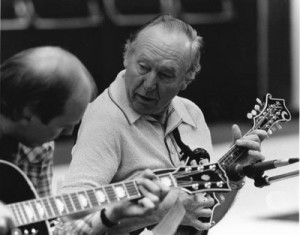Jethro (Kenneth Burns)

Jethro
Kenneth C. Burns (March 10, 1920 – February 4, 1989) was an American country musician, comedian, and mandolin player. He was better known by his stage name Jethro from his years with Henry D. Haynes as part of the comedic musical duo Homer and Jethro beginning in 1936.
Burns was born in Conasauga, Tennessee on March 10, 1920. His family moved to Knoxville, Tennessee when he was three. In 1936, he auditioned for a talent contest at Knoxville radio station WNOX where he met Henry Haynes, also 16. The two formed a duo and WNOX program director Lowell Blanchard gave them the stage names Homer and Jethro after forgetting their names on the air.
Burns was drafted into the US Army and served in Europe during World War II and reunited with Haynes, who had served in the Pacific, in Knoxville in 1945. By 1947, the duo moved to Cincinnati, Ohio and were working at WLW on the station’s Midwestern Hayride. They signed with King Records, where they worked as a house band and recorded singles on their own, and two years later signed with RCA Records. The pair were fired along with other stars by new management at WLW in 1948, and after a brief tour, they moved to Springfield, Missouri and performed on KWTO with Chet Atkins, the Carter Family and Slim Wilson.
In 1949, they moved to Chicago, Illinois and played at the Chicago Theatre. Between shows, they would go to WLS to appear live on National Barn Dance. While performing on WLS, Burns met and married his wife, Lois Johnson, who he called Gussie. Her twin sister Leona was married to Atkins.
In 1959, they won a Grammy for the best comedy performance in 1959 for “The Battle of Kookamonga”, a parody of Johnny Horton‘s “Battle of New Orleans“.
Burns was a highly-influential mandolin stylist, preferring clean single-note jazzy melodies and sophisticated chords over the dominant bluegrass stylings of Bill Monroe, and since he performed mostly in a country music setting, introduced many country mandolinists to sophisticated jazz harmonies and improvisational techniques, as well as standards from the songbooks of Duke Ellington, Django Reinhardt and Cole Porter.
By the 1970s, Burns’ influence had spread to a younger generation of bluegrass and “new-acoustic” musicians, most notably New Grass Revival mandolinist Sam Bush. His participation in Norman Blake/Tut Taylor/Sam Bush/Butch Robins/Vassar Clements/David Holland/Jethro Burns, an independently released album produced by promoter Hank Deane, was reportedly at Bush’s suggestion. During that same decade, Burns’ acquaintance with erstwhile bluegrass mandolinist David Grisman led to Burns’ writing a number of music/humor columns in the Grisman-published journal Mandolin World News. Grisman also produced a 1978 duet album on Kaleidoscope Records, Back to Back, featuring Burns and Western swing electric mandolinist Tiny Moore. Although Burns and Moore were approximately the same age and were among the few of their generation to make their reputations playing jazz and swing mandolin, the two had never met prior to the production of the album, its liner notes report.
After Haynes died in 1971, Burns’s regular musical partner was guitarist Ken Eidson, with whom he co-authored an influential mandolin method tome (Mel Bay’s Complete Jethro Burns Mandolin Book, still in print), and they continued to perform as Homer and Jethro. After the partnership ended, Burns continued to play, most notably with Chicago folk singer Steve Goodman. He appeared on several of Goodman’s albums and also toured nationally with him. At times he appeared in the Million Dollar Band on TV’s Hee Haw with Atkins and swing fiddler Johnny Gimble. He also became a master teacher of mandolin jazz. He died in 1989 from prostate cancer in Evanston, Illinois.
Born
- March, 10, 1920
- Knoxville, Tennessee
Died
- February, 04, 1989
- Evanston, Illinois
Cause of Death
- Cancer
Cemetery
- Unknown
Other
- Burns did not want a funeral and body was cremated

